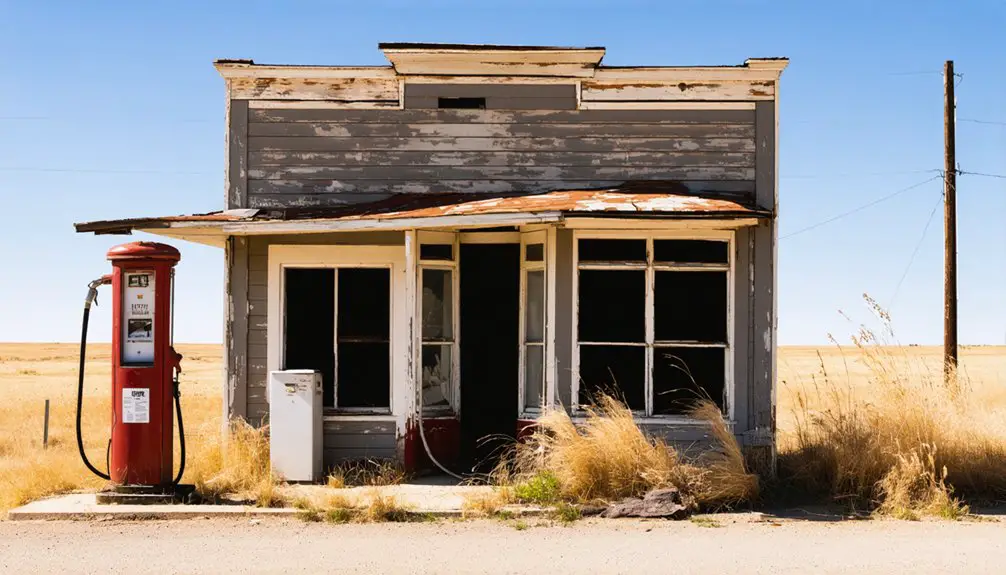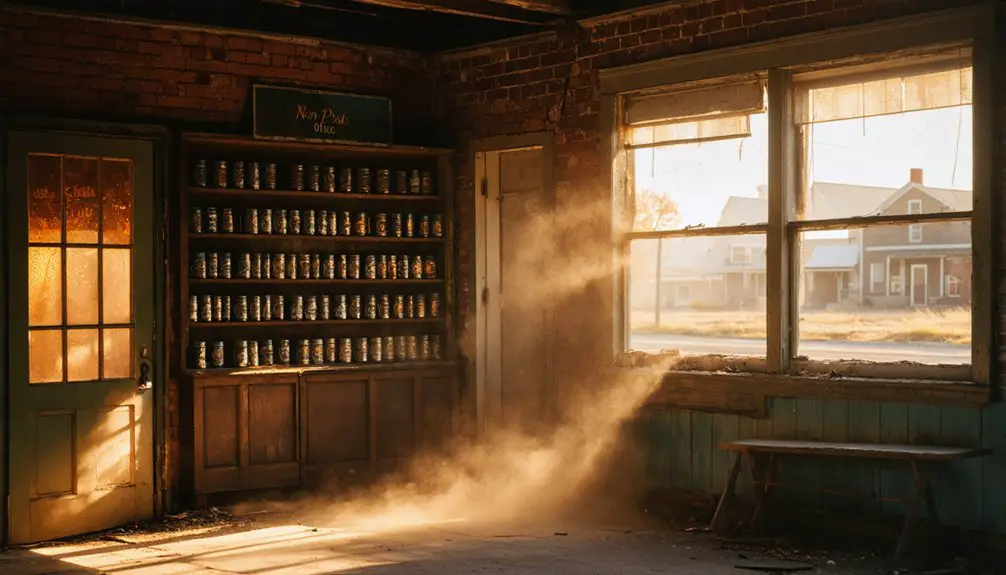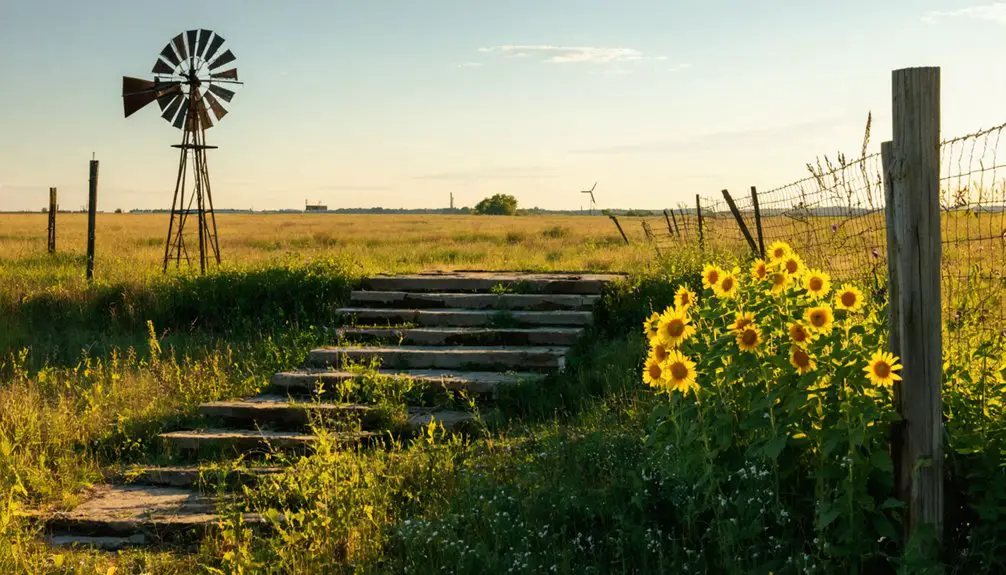You’ll find Non, Oklahoma’s ghost town traces back to early 1900s frontier settlement, when it thrived as a hub for farming, mining, and oil production. The town’s strategic location along trade routes initially drove its growth, complete with general stores, schools, and postal services. By the 1920s, drying oil wells and railroad bypass routes led to Non’s steady decline. Today, you’ll discover partially standing buildings, stone foundations, and fascinating local legends among its abandoned remains.
Key Takeaways
- Non, Oklahoma thrived during the oil boom era but declined when oil wells ran dry in the early 1920s.
- The town’s isolation intensified when major highways and railroads bypassed it, leading to economic decline and population loss.
- Physical remains include partially standing buildings, stone foundations, and archaeological evidence of early 20th-century settlement.
- The community once featured general stores, schools, and postal routes before gradually losing essential services.
- Environmental challenges, including floods and tornadoes, combined with economic factors to accelerate the town’s abandonment.
The Rise and Fall of a Frontier Settlement
While many Oklahoma frontier settlements experienced rapid growth during the territorial period, Non emerged as a promising community driven by the economic opportunities of cattle ranching and frontier trade.
You’d find essential services quickly taking root, with general stores, schools, and postal routes establishing themselves to serve the growing population. Community events and local governance efforts fostered a strong sense of social connection among settlers. The town’s relative stability was challenged when devastating floods and tornadoes struck the region. Like many other communities that became ghost towns in Oklahoma, Non’s fate was sealed by a combination of economic and environmental factors.
However, Non’s prosperity wouldn’t last. When railroads bypassed the town, its economic isolation began. The shift from stagecoach routes to railways spelled trouble, while resource depletion – from water to timber – further strained the settlement’s sustainability.
As environmental challenges mounted and transportation networks favored other locations, you’d see families and businesses gradually relocating to more promising areas, leaving Non to fade into history.
Historical Origins and Early Development
Before Non emerged as a frontier settlement, the region’s rich history stretched back to nomadic Indian tribes who used the land for hunting grounds.
You’ll find cultural influences shaped by Spanish and Mexican control before the area became U.S. territory, earning its “No Man’s Land” nickname due to its exclusion from formal jurisdictions.
Settlement dynamics intensified after 1826 when the Cimarron Cutoff of the Santa Fe Trail crossed the region, with traffic surging during the 1849 California gold rush.
The Cimarron Cutoff brought waves of westward travelers, transforming a remote wilderness into a bustling corridor of opportunity and adventure.
The area’s lawless reputation grew as William Coe built his fortified “Robber’s Roost” in the 1860s, taking advantage of the ridge’s strategic elevation. His gang engaged in cattle rustling and raiding across the territory until their eventual downfall in 1867.
Without formal governance, the region attracted a mix of cattlemen, outlaws, and opportunistic settlers who established makeshift communities around natural resources and trading routes. Like many frontier towns that followed, the area experienced widespread lawlessness and violence reminiscent of Oklahoma’s later boomtown Whizbang.
The Role of Local Industries and Commerce
You’ll find Non’s early commercial identity tied closely to wheat farming and small-scale agriculture that supported the surrounding rural community in the early 1900s.
Like many towns in Oklahoma during this era, Non experienced significant changes due to economic shifts that transformed the region.
Local farmers would’ve brought their grain to Non’s mill, which served as a crucial trade hub alongside general stores that provided essential supplies to area residents.
While some Oklahoma ghost towns thrived on oil extraction or liquor trade during this period, Non’s economy remained primarily focused on agricultural commerce until its eventual decline. The introduction of railroad transportation routes dramatically impacted whether towns like Non would survive as viable communities.
Agricultural Trade Impact
During the late 19th century, Non’s agricultural trade played an essential role in shaping the town’s early development and eventual decline. You’ll find that Non’s fate, like many Oklahoma agricultural communities, hinged on its ability to adapt to market fluctuations and maintain agricultural sustainability. Communities relied on vigilante groups to maintain order and protect agricultural interests.
The town’s commerce initially thrived through strategic placement along established trade routes, with local stores and mills supporting regional farming operations. Agricultural activity expanded rapidly as the territory saw an increase from 8,826 farms in 1890.
However, you’d have seen the significant impact of transportation infrastructure on Non’s survival. When railroad development bypassed the community, it severely limited farmers’ ability to ship their goods to larger markets.
This isolation from major trade arteries ultimately contributed to Non’s economic downturn, as surrounding communities with better rail access attracted more business and settlers.
Mining and Resource Extraction
While Non’s agricultural activities declined, the region’s mining industry emerged as a significant economic force within Oklahoma’s resource extraction landscape. Similar to many ghost towns across America, the area’s fate was tied to its natural resources.
You’ll find that mining techniques in areas like Picher revolutionized the state’s mineral production, particularly in lead and zinc extraction. The area thrived with over 11,000 workers during its peak years in the 1920s. By 1915, the Tri-State district had become the world’s largest zinc producer, generating over $1 billion in minerals by mid-century.
The environmental consequences were severe and long-lasting. Deep mining shafts, later flooded with acid-contaminated water, leaked toxic metals into local water supplies.
The process left behind massive chat piles – toxic mixtures of crushed rock containing lead and iron. These mining operations, while profitable through the 1960s, ultimately led to structural instability, forcing businesses to close and residents to abandon their properties.
Liquor Trade Activities
As frontier settlements emerged across Oklahoma Territory in the late 1800s, Non’s proximity to key trading routes positioned it as a strategic location for the region’s liquor trade.
You’ll find that Non’s economy thrived on serving thirsty cowboys and cattle dealers through its network of saloons and dance halls.
- Hidden cellars beneath buildings stored contraband spirits
- Lookouts posted along trading routes warned of approaching lawmen
- Local ranchers’ wagons concealed bottles in false-bottom compartments
- Underground tunnels connected key liquor smuggling locations
After Oklahoma’s statehood in 1907 brought strict prohibition laws, Non’s entrepreneurs shifted to bootlegging operations.
The town’s remote location and established trading networks made it perfect for clandestine liquor distribution, with profits often buried in the surrounding countryside to avoid detection by authorities.
Transportation Routes and Their Impact

The development of transportation routes played a decisive role in both Non’s establishment and eventual decline. You’ll find that the Rock Island Railroad spur initially brought life to this remote town, enabling settlers to establish stores and conduct trade in what was previously an isolated area.
As transportation evolution progressed, Non’s fate shifted dramatically. When newer highways bypassed the town, you could see the impact almost immediately.
The shift from horse-cart paths to railroads and eventually to modern highway systems left Non in economic isolation. While the railroad had once guaranteed the town’s survival by facilitating commerce and agricultural trade, its diminishing importance spelled trouble.
Progress bypassed Non, transforming a once-bustling railroad hub into a forgotten remnant of transportation’s evolving landscape.
The combination of reduced rail service and being left off major highway routes ultimately pushed Non toward ghost town status.
Daily Life in Non’s Peak Years
During Non’s peak years in the oil boom era, you’d find a bustling community driven by the rhythms of drilling operations and related commerce.
As you walked the wooden sidewalks, you’d experience a town alive with social dynamics shaped by oil workers, their families, and the merchants who served them.
Community gatherings happened regularly at local establishments, where you could:
- Join fellow workers at the saloon after shifts, sharing stories of the day’s drilling
- Attend weekend dances where both single men and local families socialized
- Participate in sporting events that brought the diverse population together
- Visit the general store, a hub for catching up on local news and trading gossip
The unpredictable nature of oil production meant you’d witness constant changes in the town’s population and prosperity, but the spirit of community persisted.
The Gradual Decline and Abandonment

Once Non’s oil wells began running dry in the early 1920s, you’d witness the town’s slow but inevitable decline into abandonment.
By the mid-1920s, you’d see younger residents moving to larger cities, leaving behind an aging population struggling to maintain community cohesion. The town’s isolation intensified when major highways bypassed it, cutting off crucial commerce and through traffic.
Environmental degradation from years of resource extraction took its toll on the surrounding landscape.
The final blow came when changing jurisdictional boundaries reduced local autonomy, and the loss of indispensable services – schools, churches, and law enforcement – accelerated the exodus.
Physical Remnants and Archaeological Findings
Today you’ll find modest structural evidence of Non, Oklahoma through partially standing buildings, stone foundations, and scattered building debris typical of late 19th-century Panhandle settlements.
Archaeological investigations have revealed domestic artifacts including ceramics, glass bottles, and metal tools concentrated in household refuse areas and middens.
Surface surveys and test pit excavations have uncovered postholes, cellar depressions, and trash pits that help reconstruct the ghost town’s original layout and daily life patterns.
Structural Remains Today
Physical remnants of Non, Oklahoma reveal a scattered array of structural evidence typical of early 20th-century ghost towns.
You’ll find various structures in different states of structural integrity, from partially standing walls to complete foundations. Despite minimal preservation efforts, several key features remain visible across the former townsite:
- Weathered timber frames and brick foundations of former homes and businesses, showcasing traditional building methods
- Aged infrastructure elements including old rail beds, bridge supports, and remnants of utility systems
- Stone and concrete foundations marking the original town layout
- Cemetery grounds with historic headstones and family plots, some still maintaining boundary markers
These archaeological remains offer you a glimpse into Non’s past as a once-thriving community, though time and elements continue their steady erosion of the site’s physical history.
Archaeological Site Evidence
Archaeological investigations at Non have revealed a diverse collection of artifacts and structural features that document the town’s early 20th-century development.
You’ll find evidence of building foundations, brick hearths, and cellar remnants, which archaeological methodologies have carefully documented through systematic surveys and excavations.
The site’s artifact assemblage includes ceramic fragments, metal nails, and limestone pieces from original chimneys.
While some early looting occurred before formal archaeological work began, artifact preservation efforts now protect the remaining physical evidence.
The Oklahoma Historical Society manages the site’s protection and interpretation, following established federal guidelines.
Through careful analysis of spatial relationships between artifacts and structural remains, archaeologists have pieced together valuable insights about Non’s settlement patterns and daily life during its brief period of occupation.
Local Legends and Folklore

Like many abandoned settlements across Oklahoma, Non has accumulated its share of haunting legends and supernatural folklore over the years.
You’ll hear tales of ghostly encounters after dark and spectral sightings near the town’s abandoned structures, often tied to tragic events and supposed curses from its brief period of habitation.
- Mysterious figures and shadows dart between crumbling buildings
- Unexplained voices echo through empty streets
- Strange lights appear along deserted roads at night
- Phantom residents seem to guard their former properties
The stories blend multiple cultural traditions, from Native American oral histories to European settler accounts, creating a rich tapestry of supernatural lore.
Local urban legends often serve as cautionary tales, warning travelers about trespassing on these historically charged grounds where unresolved spirits are said to linger.
Preserving Non’s Historical Legacy
While supernatural tales capture imaginations, the true preservation of Non’s legacy depends on dedicated research and documentation efforts.
You’ll find extensive scholarly work has already cataloged Non among Oklahoma’s 100 ghost towns, drawing from over 1,200 sources and firsthand data collection spanning 8,000 miles of travel.
Today’s preservation strategies face dual challenges: human vandalism and environmental decay threaten Non’s remaining structures, while limited funding hampers maintenance efforts.
Yet, through community engagement and partnerships with organizations like the National Trust for Historic Preservation, you can participate in protecting these crucial historical sites.
Working together with preservation groups empowers communities to safeguard historic places for generations to come.
Grant programs and heritage tourism initiatives offer practical solutions for Non’s conservation, ensuring that future generations will understand the town’s role in Oklahoma’s economic and social evolution.
Frequently Asked Questions
Are There Any Paranormal Investigations or Documented Ghost Sightings in Non?
You’d think a ghost town would have ghost stories galore, but there aren’t any documented paranormal investigations or haunted locations in Non. The town’s spirits have kept their secrets well-hidden.
What Dangerous Wildlife or Hazards Should Visitors Watch for Today?
You’ll need to watch for rattlesnakes, coyotes, and mountain lions during wildlife encounters. Stay alert for unstable buildings, hidden shafts, and sharp debris. Always bring water and take basic safety precautions.
Can Metal Detectors Be Legally Used to Search Non’s Grounds?
You’ll need permits due to metal detecting laws and historical preservation restrictions. Without proper authorization, you’re prohibited from searching Non’s grounds – whether it’s public land or private property.
Are There Any Annual Events or Gatherings Held at Non?
You won’t find any official annual gatherings or local traditions at this site today. The ghost town’s remote location and lack of infrastructure don’t support organized events or regular festivities.
Who Owns the Land Where Non Once Stood?
Like a dusty chapter in history’s book, you’ll find the land where Non stood is privately owned today, though records of exact ownership are maintained at Cimarron County’s administrative offices.
References
- https://beerconnoisseur.com/articles/infamous-wild-west-ghost-town-beer-city-oklahoma/
- https://en.wikipedia.org/wiki/List_of_ghost_towns_in_Oklahoma
- https://www.youtube.com/watch?v=5d-wHDTIbb0
- https://www.okhistory.org/publications/enc/entry?entry=GH002
- https://okmag.com/blog/a-ghostly-site/
- https://www.youtube.com/watch?v=LUbwVR0z0nA
- https://www.okhistory.org/publications/enc/entry?entry=AL009
- https://www.legendsofamerica.com/ok-kenton/
- https://nondoc.com/2022/01/04/whizbang-oklahoma-ghost-town/
- https://www.potawatomi.org/blog/2021/04/09/remembering-potawatomi-ghost-towns/



